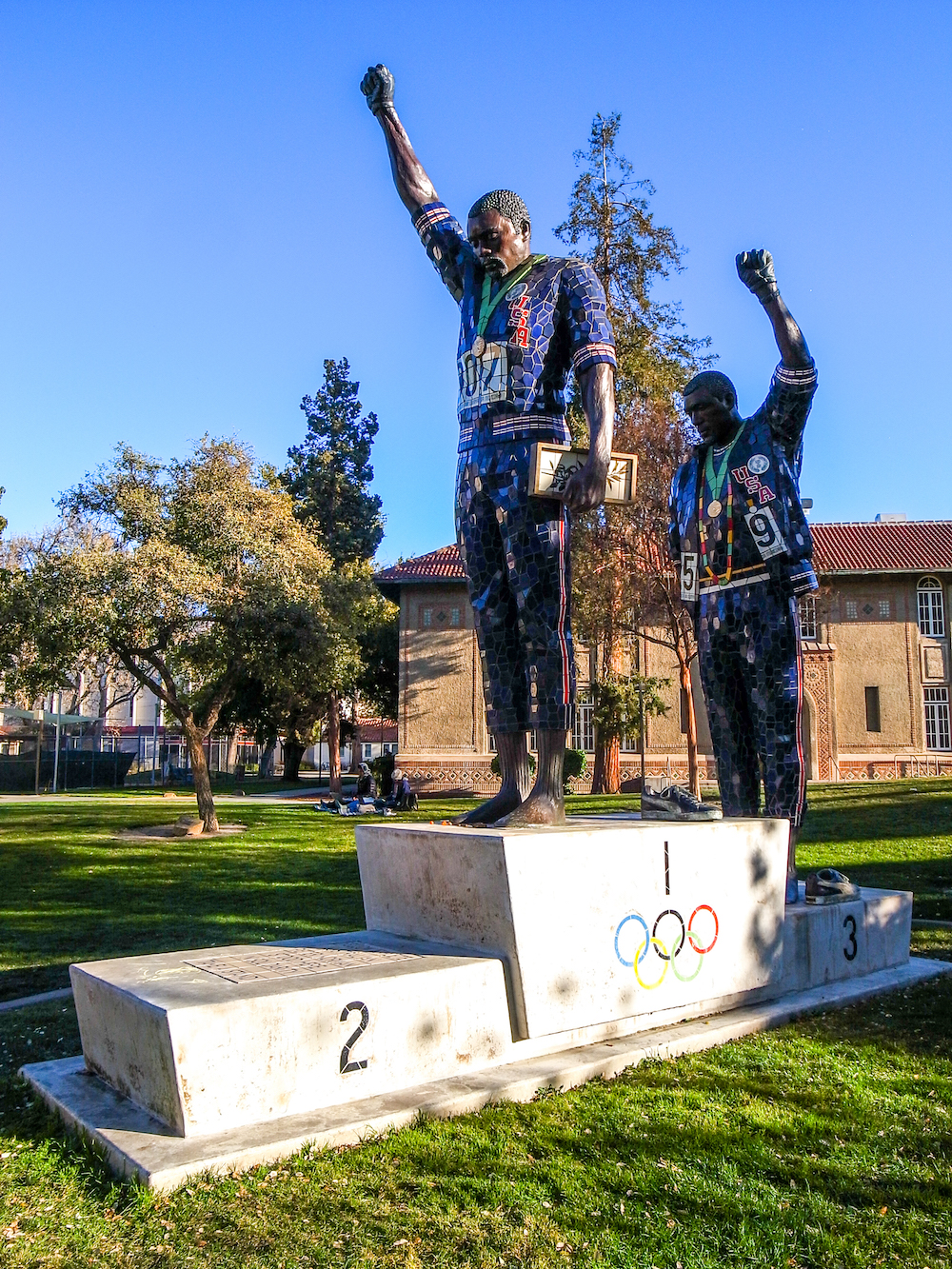Victory Salute

Photographer: Hunter Ridenour (2022)
Artwork: Victory Salute (Olympic Black Power)
Artist: Rigo 23
Year: 2005
Commissioned by: San José State University
History
Designed by artist, Rigo 23, this larger-than lifesize fiberglass and mosaic monument, centrally placed on San José State University’s Tower Lawn, depicts the heroic and symbolic action of two African-American athletes and San José State University alumni, Tommie Smith (24) and John Carlos (23), who during the medal ceremony for the 200-meter running final in the Olympic Stadium in Mexico City on October 16, 1968, performed the Black power salute, raising their fists in silent protest.
Smith, in the first place spot and Carlos, in third, planned and executed the gesture to draw attention to injustice and inequality faced by Black Americans but were greeted with boos and threats from the audience. Rendering the iconic moment through details such as the gloved hands and shoeless feet of the two athletes, Rigo 23 shows that the gesture was not accidental but planned for maximal symbolic effect.
Reenacted at SJSU in monumental form, Smith and Carlos’s protest and call towards justice is uplifted and celebrated. The second place podium spot, left empty, invites spectators to imagine themselves alongside the two icons and to follow their example in pledging to take responsibility and action towards eradicating anti-Black racism and bias.
Public Art as Resistance
Clad in the colors of the nation that denied African American civil rights, Smith and Carlos took a stand to draw global attention to inequality in the United States. Portrayed larger than life, their action on the medal podium echoes the chants of “Black Lives Matter,” the continuation of work to achieve dignity, equality, and justice for all citizens of this country.
The statue poses a paradox for viewers. Demonstrating the harnessing of education, self-determination, and accepting of consequences to challenge the inequities of the status quo, while located on a campus of higher education at a time when those seeking an education and independence are doing so at significant financial cost to themselves, their families, and their futures. The work for dignity, equity, and justice has and continues to take on obstacles that are meant to slow and discourage progress.
Movements for equity find support among the unsung who go without recognition. The absence of silver medal winner Peter Norman of Australia, who supported Smith and Carlos’ protest, is a reminder that all people have a responsibility to humanity to stand up against intolerance and bigotry.
Continue Your Walk
As you walk to your next stop, you’ll notice two notable arts and cultural institutions, the San José Museum of Art and the Cathedral Basilica of San José. Fine arts housed in cultural institutions can create unintentional entry barriers where public art does not. Sculptures placed on sidewalks and murals found on building walls are freely critiqued by anyone at any time which in itself is a means of resistance to ticketed and invited art viewing experiences.
For the next public art, look for the restaurant, Mezcal - and peek around the side of their building for a fantastic view.
Additional Sources
- "With Drawn Arms: Glenn Kaino and Tommie Smith" Exhibit @ San Jose Museum of Art (Nov 2019-April 2020)
- Iconic: San Jose State Responds Exhibition, created by SJSU students enrolled in Art History 101 with Dr. Dore Bowen (Winter, 2020).
- Sports: Leveling the Playing Field Exhibit, Smithsonian Museum of African American History with recorded conversations with John Carlos, digital exhibit materials, and more
- "John Carlos sits on the base of his own statue" (Jan 24, 2016 - Washington Post) regarding the opening of the new Smithsonian Museum of African American History where a similar statue resides
- See more about this landmark and the living legacy at San José State University’s Landmarks and Legacy of Athlete Activism
- About Rigo23 - SFMOMA (video)
- “Carlos and Smith Reflect on 1968 Olympics Protest 50 Years Later at
- San Jose State” NBCBayArea
- "Peter Norman, the White Man in that Photo" by Riccardo Gazzaniga in The Wire (2020)
- "Tommie Smith, John Carlos, and the Statues" in Racial and Social Justice at San José State University